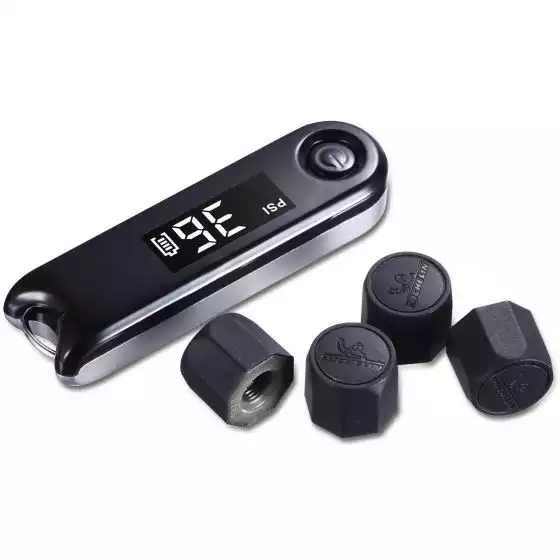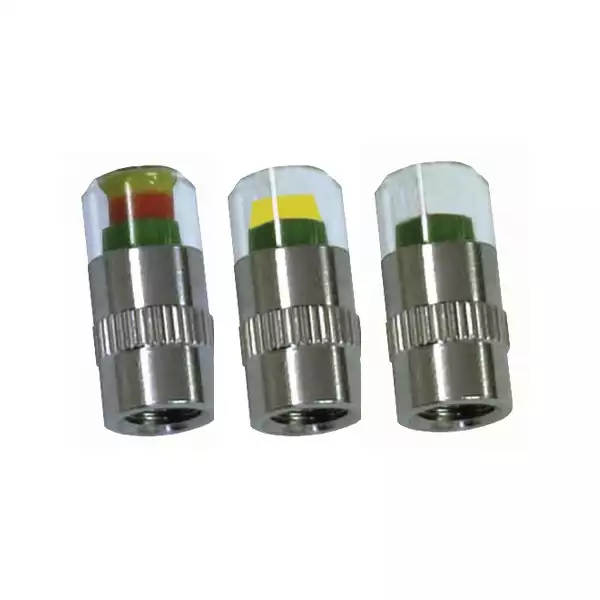A tyre pressure monitoring system (TPMS) eliminates the need for regular checks with a manual gauge.
By giving the rider real-time feedback on the tyre’s current pressure, these systems help you avoid accidents, uneven tyre wear and poor fuel economy.
If you’re forgetful, consider getting one.
 Michelin Fit2Go Tyre Pressure Checker
Michelin Fit2Go Tyre Pressure Checker
Simple, Effective and Hassle-Free
Affordable and a good compromise for those who want neither a full display on their handlebars nor an app running on their phone.
 Bike It Pressure Alert
Bike It Pressure Alert
Cheap Low Tech Solution
It’s not the most accurate on our list, but it’s simple, reliable and 1/10 the cost of some of its higher-end competition.
Best Motorcycle Tyre Pressure Monitoring System
Michelin Fit2Go Tyre Pressure Checker
An excellent solution for anyone trying to keep visual impact from accessories to a minimum. Some of us are in this camp – unwilling to mount even our smartphones on the handlebars, never mind a host of other displays.
Screw the valve cap sensors on and use the keyring display to view the tyre pressure.
Technically it’s not a fully-fledged TPMS as it is not monitoring your tyres constantly, and it’s not intended to be read or operated in motion. Instead, you use it before every ride to check pressures.
We love the simplicity of this system, and it’s so easy to use that checking pressures regularly is much less of a faff and, therefore, much more likely to get done.
Best of all, the sensors are battery-free, and the keyring is rechargeable. Fit2Go indeed.
Pros
- Simple
- Excellent battery life
- As safe as the most expensive options
Cons
- Limited display
Bike It Pressure Valve Cap
Check Prices on SportsBikeShop
An affordable and elegant option from Bike It.
It’s a valve cap solution. But, rather than pairing to your phone or a display for feedback – these give a reading on the tyre.
The valve caps display two colours – green when the pressure is correct and red when it drops below the minimum rating. Four versions are available in different psi ratings. Make sure to buy the one rated for the same psi range as your bike.
This doesn’t have the same accuracy or real-time monitoring level as the others on our list, but it’s a fraction of the price.
The significant drawbacks are no display and no alarm system. More advanced (and expensive) solutions can potentially warn you of an impending blowout or slow puncture. This makes them ultimately safer. Still, Bike Its Pressure Valve Caps are much better than no TPMS solution.
Pros
- Inexpensive
- Reliable and durable
- Way better than no TPMS
Cons
- No real-time monitoring or alerts
FOBO Bluetooth TPMS
An easy-to-fit valve cap and app solution for iOS/Android. These can get convoluted and cluttered with too many in-app options, but this one keeps the user interface pretty simple. Custom thresholds, alarms and other advanced features are accessible too.
One great feature here is that it does offer 24/7 monitoring. You’ll get an alert on your phone any time the pressure in your tyres drop (it can be switched off).
We think we’d rather know about a puncture when it happens than when we’re already in a rush to be somewhere.
Pros
- Easy to fit and pair
- 24/7 pressure monitoring
- Optional advanced features
Cons
- Expensive
Buyer’s Guide
What to consider before shelling out for a tyre pressure monitoring system.
What Is TPMS?
TPMS stands for “tyre pressure monitoring system”. Most modern cars already include a system like this. In some countries, this is a legal requirement for all motor vehicles.
Newer, higher-end bikes will have some TPMS built-in. But if you’re riding something more basic, vintage or older, you may have to look into an aftermarket solution.ion
Why Should I Get One?
The primary function of these systems is safety. Still, incorrectly inflated tyres also hurt your fuel economy and cause uneven tyre wear, negatively affecting tyre tread depth.
The products on our list range from high-tech Bluetooth solutions with digital displays to simple mechanical devices with colour-coded indicators.
In reality, checking with a tyre pressure gauge before riding is almost as effective, but a TPMS makes the process much more straightforward and makes it less likely you’ll forget to check your pressure.
Types of Monitor
External Sensor:
External sensor TPMS mount on the outside of the tyre and wheel assembly. These systems most commonly come in the form of valve caps threaded onto your valve stem, replacing the original dust caps.
External sensors are more common as they’re cheaper and easier to fit. But because they’re fitted to the outside of the tyre (not the area that’s supposed to be pressurised), they aren’t as accurate as internal sensors. They’re also more likely to be stolen/knocked off.
Internal Sensor:
Internal TPMS are fitted inside the tyre wall. While this is the only way to 100% guarantee the accuracy of pressure readings, it’s also much more difficult and expensive to install (you need to remove both wheels and tyres!).
These systems are less common as aftermarket solutions but are often the type fitted OEM in the factory.
Factory Fitted:
These systems are whatever the manufacturer chose to install on your particular bike in that specific year. Some companies use an external valve cap style system, while others opt for internal sensor systems.
Whatever is installed from the factory is probably well-tested, (maybe) under warranty and best repaired by someone who knows what they’re about.
Display Options
Some TPMS require a display to be mounted around your instrument cluster to let you know when there’s a problem. Because they only need to display a minimal amount of information, TPMS monitors are usually pretty small and can be discreetly mounted on the bars.
If the aesthetics of this bother you, choose a system that pairs with your smartphone or a mechanical system that displays issues directly on the valve cap.
Apps
The apps that support Bluetooth TPMS on smartphones are reasonably intuitive. Advanced features include manually setting thresholds for tyre pressure and alarms with varying degrees of noise/vibration/light.
This means a slow puncture warning will take a different form than an impending blowout.
Thankfully, there isn’t much complexity here, so pairing and using all these systems isn’t a hassle. Default settings work best for 99% of commuters out of the box.
Valves
With both internal and external TPMS, the sensors that transmit data are mounted in and around the valve. Because of where they mount, TPMS can only be mounted to metal stemmed valves.
With many external TPMS, the valve cap is the system – it takes and transmits a pressure reading to a display or smartphone.
Internal TPMS are mounted underneath the valve stem inside the tyre. These systems last as long as the battery that powers them (usually 3-7 years). This is also about the average life of a motorcycle tyre, and both are intended to be changed simultaneously.
Sleep
This auto-off feature detects when the bike is stationary and turns the unit to sleep mode, extending battery life. It sees when the bike begins moving again and starts to transmit pressure readings.
All of the battery-powered units on our list feature replaceable, single batteries.
Weather proofing
This is an essential feature and, thankfully, is not an issue with these products. If problems were reported with any of the units on our list – we’d tell you.
Adventure, touring, and motocross riders all but seek out wet weather, and in the UK, even commuters need to be prepared for torrential rain.
Conclusion
The key takeaway here – any TPMS solution is better than none. Even the cheapest solution on our list is a significant upgrade on getting the dust caps off and a gauge out regularly.

